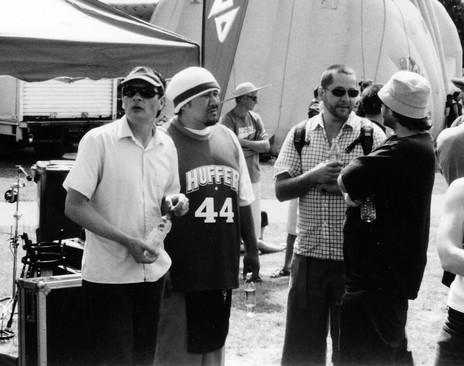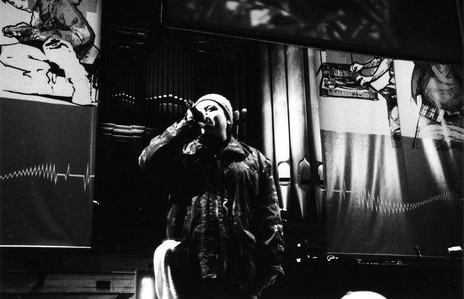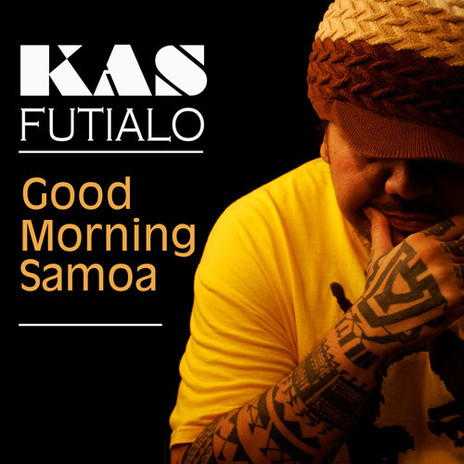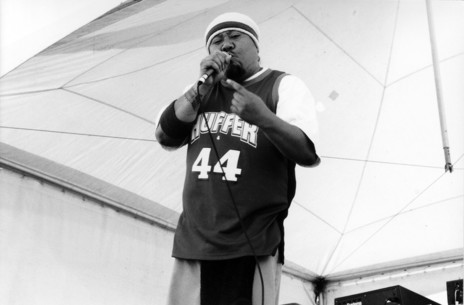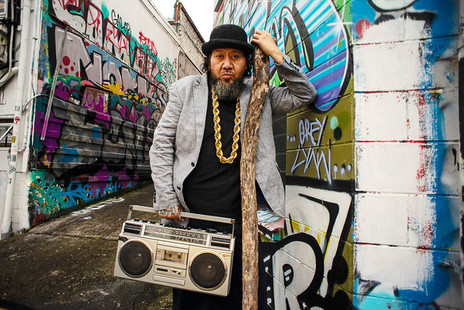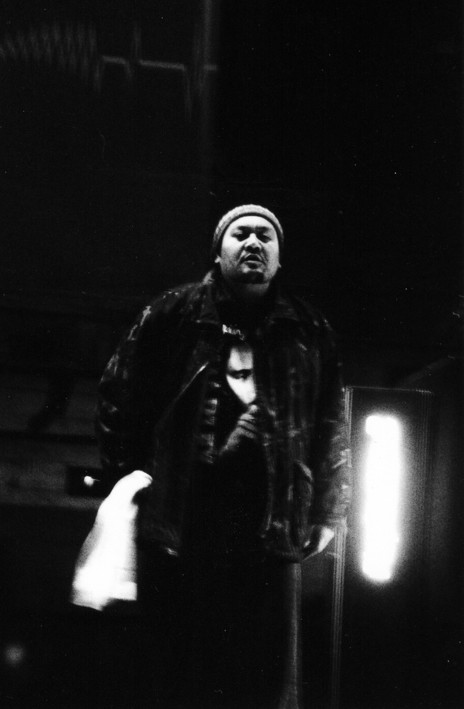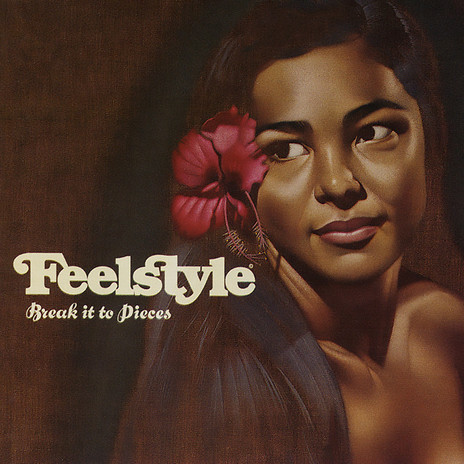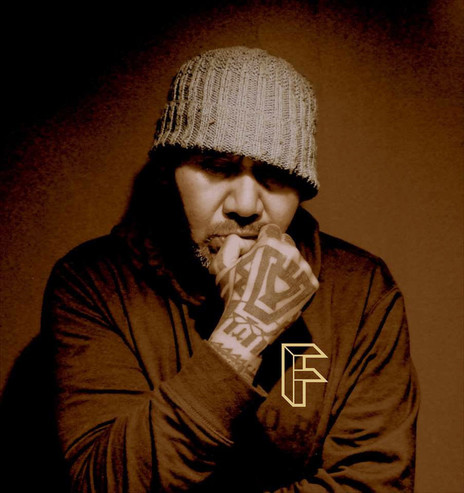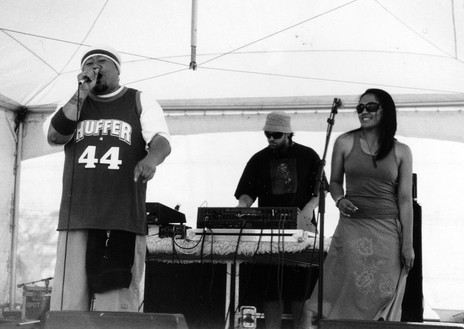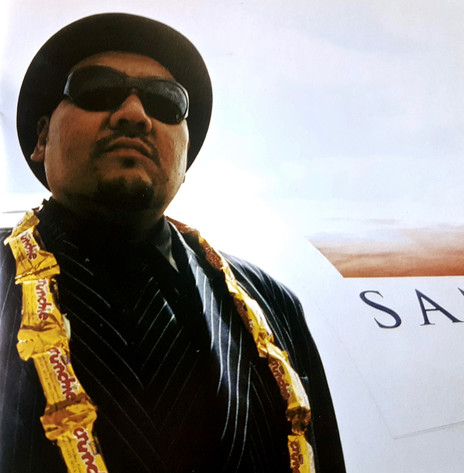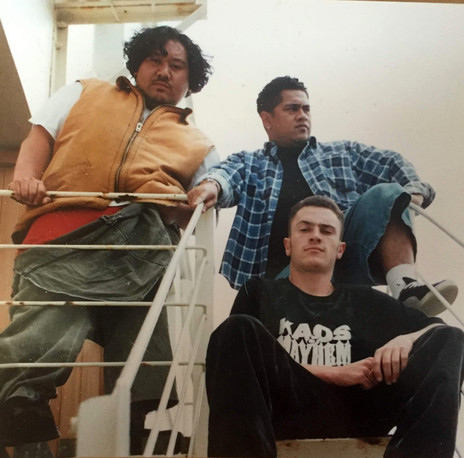Futialo was born in Sataoa on Upolu, one of the main islands of Samoa. At the time he was born, the village had no electricity, only kerosene lamps, and there was no hospital nearby, so his mother relied on the help of local women to get through the birth. When it came time to attend school, Futialo moved to live with his aunt on the far side of the island so he could attend Vaimea Primary.
An even bigger change came when he was aged nine and was sent to New Zealand to take advantage of the opportunities here. He begged not to go and was crying as he boarded the plane. In his bag, he crammed a handful of cassette tapes to remind him of home, including releases by legendary acts such as Tiama’a, the Five Stars, Punialava’a, and Penina o le Tiafau.
Push on through
As a teen, Futialo settled with his aunt in Strathmore, Wellington, and attended St Patrick’s College. His music teacher wrote a letter home to dissuade his parents from enrolling him in music for School Certificate, but he just took this rebuff as encouragement and redoubled his efforts.
Hip hop arrived in New Zealand, but Futialo wasn’t allowed to go into town to Manners Mall where the breakdancers hung out, so instead heard second-hand stories through other kids. He was soon searching out rap music and writing his own rhymes into a notebook.
His friend Vinny Viule (aka DJ Rockit V) ran a mobile disco and convinced Futialo to have a go on the mic over one of the beats he was playing. He also convinced Futialo to enter a 1987 rap competition that was held in Taita. Upper Hutt Posse were there, but it was Futialo that took away first prize.
Futialo won first prize in a rap competition held in Taita in 1987.
Futialo’s first rap group was Noise’n’effect, which took its core members from breakdance group, Twilite Thrillz. Among the group was K.O.S. Faalogo, who was inspired when he saw another member – D-Word from Upper Hutt Posse – move into making music (“K.O.S. 163” was his MC name which stood for “Known Overstayer” or “King of Styles”, while “163” was his address on Tasman Street). Noise’n’effect also included Christiaan “Crispy Fresh” Ercolano (who later formed House of Downtown) and Rockit V, who’d begun to make a name as a battle DJ by winning the Wellington round of the Numark competition in 1989.
When Futialo joined Noise’n’effect, he took the MC name RIQ (after his name, Patriq) and began to toy with the idea of rapping in Samoan. He met others on the local scene, most notably budding turntablist Ian Seumana (DJ Raw) and young rapper Bill Urale (King Kapisi).
Futialo went through a number of acts in the years that followed. He was in Conscious Navigators with Gerard Tahu (part of Tahu’s Tribal Base Collective) and then joined K.O.S. and Rockit V in Rough Opinion (originally known as The Mau – “Mau” means “opinion”). This gave Futialo his first opportunity to record professionally, as Rough Opinion were asked to write a track about safe sex – “Dem Funky Hormones” (though it wasn’t very representative of their hard-hitting political tracks).
However, Futialo’s most important stepping stone was teaming up with Urale and DJ Raw as the Overstayers. The trio formed connections with the Auckland scene through hosting visiting acts such as Dei Hamo (Sani Sagala) and Ermehn (Herman Loto), who stayed with them – an arrangement that was reciprocated when they toured. They also got beats from Auckland-based producers such as Jeremy Geor (50HZ) and Christiaan Ercolano (who was now based there). Urale finally relocated to Auckland to pursue his music and Futialo visited him there to lay down raps for the early King Kapisi recordings (before moving there himself a while later).
Outside your enclosure
Another of Futialo’s Auckland connections was providing the hook for the single ‘Walls of Steel’ by Ermehn. He was listed on the cut as “Khaz the Field Style Operator” and gave a hint of his skill at rapping in Samoan (an English language version was also recorded). When Ermehn went on to do an album, Samoans: Part Two (1998) he worked with producer Andy Morton (aka Submariner) and Futialo also met him through this connection.
That same year, Futialo had his first track released as “Tha Feelstyle” when he was included on the compilation, Aotearoa Hip Hop Vol 1 (1998) put together by Mark James Williams aka Slave (Joint Force). ‘The Anthem’ was produced by DJ Raw and laid island-style acoustic guitar over a thudding beat. A sweetly sung vocal hook was provided by Leva Finau and Tha Feelstyle was given his first serious chance to show off his easy-flowing raps in Samoan.
Tha Feelstyle contributed to King Kapisi’s ‘Screems from the Old Plantation’.
In the meantime, King Kapisi had created his own buzz with his first couple of singles. For his third single, Kapisi reunited the Overstayer crew by having Tha Feelstyle and DJ Raw appear on ‘2nd Migration’ (in the video all three wore their “Overstayer” T-shirts). It became King Kapisi’s third Top 50 entry and his album shot into the Top 10 soon after (which also featured Tha Feelstyle on another track, ‘Shellshocked’).
Tha Feelstyle’s biggest contribution to the King Kapisi album, despite it being re-sung by Kapisi himself, was writing the hook for ‘Screems from the Old Plantation’. The song wasn’t a charting single, but the video received a huge amount of play and it went on to be Kapisi’s most enduring track. Even a decade after its original release, it went on to rack up over a million streams across the various streaming platforms.
The foundation had been laid for Tha Feelstyle to create his own album, though it would take years of intensive work to bring it to fruition.
Break It To Pieces
During the recording of Samoans: Part 2, Ermehn took Futialo to the studio of Andy Morton, aka Submariner. Futialo had a backing track that he wanted to record some raps over, so Morton helped him whip up a demo. Morton was impressed by how quickly Futialo took to the task at hand, plus he’d already heard from others in the scene about this amazing rapper who could drop rhymes just as easily in Samoan as he did in English. It seemed destined that the two would work together.
Morton’s own output in the years around the new millennium was impressive to say the least: he’d produced Dam Native’s Top 40 single ‘The Son’, was heavily involved in Che Fu’s debut album, 2bSpacific (1998) and contributed beats for two of the tracks on King Kapisi’s Savage Thoughts (2000). Beyond hip hop, he’d also co-produced Mark de Clive-Lowe’s nu-jazz album Six Degrees (1999) and contributed keys and production for Bic Runga’s album Beautiful Collision (2002).
All of Morton’s experience would be brought to bear on Tha Feelstyle’s 2004 debut album, Break It To Pieces. He could play a range of instruments – most notably keys and drums – so could perform the parts for each track, though he’d often slice them up so they could be cut together like samples. His interest in funky, hip hop inspired nu-jazz is evident on some tracks and he brought in some ultra-talented players from this scene to spice up some of the recordings, including Mark de Clive-Lowe, bass player Cameron Undy, and UK synth maestro Kaidi Tatham. Most notably, the trio even came together on a Moog-led, super-funky track, ‘Going Home’, which also includes vocals from Imon Starr (Rhombus).
While recording the album, Morton also helped produce the first two Dimmer albums and played in the live band. This led to the most unusual feature on Tha Feelstyle’s album: Shayne Carter singing the chorus of ‘Savagefeel’, a track built over a beat by Justin “Juse” Ferguson. It also has a rap verse from rising star Savage – one of only two guest rappers, the other being Son Tan from Lost Tribe.
While Morton did the majority of the production on the album, Futialo did find space for one track by his old friend DJ Raw. ‘Su’amalie/Ain’t Mad at You’ was initially created by DJ Raw and he even invited Futialo’s young nieces – Jayde, Jazzmin, and Jesika Finau – over to his garage to record vocals for it. Morton then provided co-production to finish the track off.
Futialo made it sound as if the art of rapping had been created in Samoan.
As a whole, Break It To Pieces provided a wide palette of beats for Tha Feelstyle to rap over – whether it’s rhyming in Samoan over a reggae beat on ‘Mybrotherwillkillyou’ or thoughtfully examining family dynamics (in English) on ‘Enlightenment Piece’. Futialo made it sound as if the art of rapping had been created in Samoan – the big vowel sounds and guttural stops flowing perfectly over Morton’s always-funky backdrops.
Break It To Pieces was released by major label Festival Mushroom Records, so it was reassuring when they backed Futialo’s first choice of single, ‘Su’amalie’, despite it being almost entirely in Samoan. The decision was rewarded with a Top 40 placing, no doubt helped by a wonderful music video by director Chris Graham that saw Futialo returning home to Samoa – singing with kids from his old school, Vaimea Primary, and sitting outside Filipo’s Tyre store in Lalovaea, his hangout as a child.
Tha Feelstyle went on to win three awards at the inaugural Pacific Music Awards in 2005 – Best Pacific Hip Hop Artist, Best Pacific Male Artist, and Best Pacific Song for ‘Suamalie/Ain't Mad at You’ – despite being up against Scribe and Dei Hamo in some categories. The critical reception for the album was also glowing and, if anything, its stature has grown over the years. Nick Bollinger named it as one of his “essential New Zealand albums,” Grant Smithies included it in his book of “great New Zealand albums,” and Simon Sweetman listed it amongst “the best New Zealand albums I have reviewed”.
The album had one more surprise in store, which came through Morton being asked to compose the score for Sione’s Wedding. Dawn Raid were supplying most of the music for the soundtrack and at one meeting Brotha D suggested a remix of ‘Su’Ga Ea’ which used Lapi Mariner's vocal from the end of the song (“I do believe”) as the hook. Manuel Bundy was brought on board to cut up the vocal hook as if it was a sample, giving it an extra bounce. There was also additional verses by Mareko (Deceptikonz) and Flowz, which helped this version (under the name ‘I Do Believe’) to reach No.17 on the charts in early 2006.
When the dust settles
Unfortunately having a critically acclaimed album doesn’t always lead to a comfortable career, especially in a small country like New Zealand. Futialo wasn’t driven by hopes of a commercial breakthrough though. His later work would be even more focused on speaking to his community rather than reaching for a wider audience.
Initially, he joined the band Mt Vaea, which was named after the nightclub (and mountain) of the same name in Apia. Tha Feelstyle contributed raps to their album, Mama (2006), which not only received “Best Pacific Album” and “Best Pacific Group” at the local music awards, but also led Mama to be named “Best Polynesian Album” at the Hawaiian Music Awards.
Futialo then released a new solo album, Lokokasi (2008), entirely in Samoan which was focused primarily on the Polynesian music market. In 2010, he released an English-language single, ‘Sometimes When It Rains’, which had chart-toppers Adeaze on the chorus. He followed this with an album, Good Morning Samoa (2012), which came out under his own name, Kas Futialo, and received three award nominations at the Pacific Music Awards.
Futialo has a desire to represent
Samoa at all times and give back to his community through his music.
In 2018, new-on-the-scene rapper, Tha Movement, collected together some of the best Samoan rappers in Auckland for a track, ‘Masta’, and it was no surprise to find Tha Feelstyle among the handpicked line-up (supplying a verse in Samoan, of course). The track went on to be featured on the Fast and Furious spinoff movie, Hobbs and Shaw (2019). Futialo’s close connection to his Samoan roots was also captured in the short film, The Crossroads: Le Māgafā (2018), which was directed by Sani Sagala (Dei Hamo) and showed Futialo visiting his home country.
Tha Feelstyle also had a chance to appear on a track by Punialava’a from their album, Yesterday, Today & Tomorrow O ananafi, O nei ma Taeao (2018), which won Best Pacific Language Album at the Pacific Music Awards in 2019. However, the true importance of this collaboration went deeper for Futialo. An album by Punialava’a was one of the cassettes that he packed in his bag when he first moved to New Zealand and it provided a lifeline to the Samoa he had left behind. His appearance on one of their tracks was a sign of the goal that now guides him – a desire to represent Samoa at all times and give back to his community through his music.
